Process for preparing electron deficient olefin precursors
Duffy , et al. February 9, 2
U.S. patent number 10,913,708 [Application Number 16/438,584] was granted by the patent office on 2021-02-09 for process for preparing electron deficient olefin precursors. This patent grant is currently assigned to Henkel IP & Holding GmbH. The grantee listed for this patent is Henkel IP & Holding GmbH. Invention is credited to Barry Burns, Cormac Duffy, Marisa Phelan.
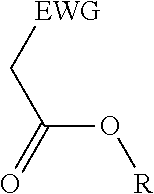
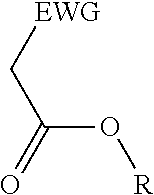
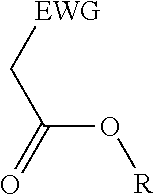
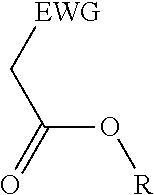
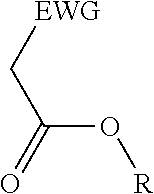
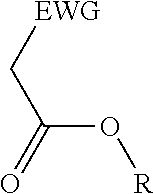


| United States Patent | 10,913,708 |
| Duffy , et al. | February 9, 2021 |
Process for preparing electron deficient olefin precursors
Abstract
This invention relates to a process for producing electron deficient olefin precursors, such as 2-cyanoacetates, using an acid catalyzed esterification reaction.
| Inventors: | Duffy; Cormac (Dundalk, IE), Phelan; Marisa (Roscrea, IE), Burns; Barry (Dublin, IE) | ||||||||||
|---|---|---|---|---|---|---|---|---|---|---|---|
| Applicant: |
|
||||||||||
| Assignee: | Henkel IP & Holding GmbH
(Duesseldorf, DE) |
||||||||||
| Family ID: | 1000005350116 | ||||||||||
| Appl. No.: | 16/438,584 | ||||||||||
| Filed: | June 12, 2019 |
Prior Publication Data
| Document Identifier | Publication Date | |
|---|---|---|
| US 20190292143 A1 | Sep 26, 2019 | |
Related U.S. Patent Documents
| Application Number | Filing Date | Patent Number | Issue Date | ||
|---|---|---|---|---|---|
| PCT/EP2017/082348 | Dec 12, 2017 | ||||
Foreign Application Priority Data
| Dec 23, 2016 [GB] | 1622099.8 | |||
| Current U.S. Class: | 1/1 |
| Current CPC Class: | B01J 23/10 (20130101); B01J 27/12 (20130101); B01J 21/066 (20130101); B01J 23/20 (20130101); C07C 253/30 (20130101); C07C 253/30 (20130101); C07C 255/19 (20130101); B01J 2531/38 (20130101); B01J 31/0227 (20130101); B01J 2231/49 (20130101) |
| Current International Class: | C07C 253/30 (20060101); B01J 21/06 (20060101); B01J 23/10 (20060101); B01J 23/20 (20060101); B01J 27/12 (20060101); B01J 31/02 (20060101) |
References Cited [Referenced By]
U.S. Patent Documents
| 2756251 | July 1956 | Joyner et al. |
| 2763677 | September 1956 | Jeremias |
| 3142698 | July 1964 | Halpern et al. |
| 3654340 | April 1972 | Banitt |
| 3728375 | April 1973 | Coover, Jr. et al. |
| 3903055 | September 1975 | Buck |
| 3975422 | August 1976 | Buck |
| 4003942 | January 1977 | Buck |
| 4012402 | March 1977 | Buck |
| 4013703 | March 1977 | Buck |
| 4202920 | May 1980 | Renner et al. |
| 4364876 | December 1982 | Kimura et al. |
| 4512357 | April 1985 | Earl |
| 4587059 | May 1986 | Harth et al. |
| 5386047 | January 1995 | Nakos et al. |
| 2721858 | October 1995 | Joyner et al. |
| 5455369 | October 1995 | Meier et al. |
| 5624699 | April 1997 | Lang |
| 5703267 | December 1997 | Takahashi et al. |
| 6096848 | August 2000 | Gololobov et al. |
| 6245933 | June 2001 | Malofsky et al. |
| 6436866 | August 2002 | Nishikido et al. |
| 7569719 | August 2009 | McArdle et al. |
| 7659423 | February 2010 | McArdle |
| 7718821 | May 2010 | Bigi et al. |
| 8022251 | September 2011 | McArdle et al. |
| 8053589 | November 2011 | McArdle et al. |
| 8329936 | December 2012 | Friese et al. |
| 8481755 | July 2013 | McArdle et al. |
| 8686105 | April 2014 | McArdle et al. |
| 2012/0023021 | January 2012 | Seifert et al. |
| 103922964 | Jul 2014 | CN | |||
| 2738285 | Mar 1979 | DE | |||
| 0459617 | Dec 1991 | EP | |||
| 2012106982 | Jun 2012 | JP | |||
| 2015004566 | Jan 2015 | WO | |||
| 2015150882 | Oct 2015 | WO | |||
Other References
|
Ilangovan, A.; Muralidharan, S. and Maruthamuthu, S. "A Systematic Study on Knoevenagel Reaction and Nazarov Cyclization of Less Reactive Carbonyl Compounds Using Rare Earth Triflates and Its Applications." Journal of the Korean Chemical Society, vol. 55, No. 6, 2011. cited by applicant . Wen-Bun, Y. et al. "Ytterbium Perfluorooctanesulfonate-Catalyzed Knoevenagel Condensation in Fluorous Biphasic System", Organic Preparations and Procedures International, vol. 39, No. 1, 2007, pp. 71-75. cited by applicant . Narsaiah, A. et al. "An Efficient Knoevenagel Condensation Catalyzed by LaC13. H2O in Heterogenous Medium." Synthetic communications, vol. 33, No. 21, 2003, pp. 3825-3832. cited by applicant . Remme, N. et al. "Scandium Triflate Catalyzed Transesterification of Carboxylic Esters", Synlett, vol. 20007, No. 3, 2007, pp. 491-493. cited by applicant . Fu, X. et al. "Transesterification catalyzed by samarium tri-2-propoxide", Chinese Journal of Chemistry, vol. 15, No. 1, 1997, pp. 90-93. cited by applicant . Vijayalakshmi, V. et al. "Alkyl and substituted alkyl 2-cyanoacrylates. Part 1. Synthesis and properities" J. Adhesion Sci. Technol., vol. 4, No. 9, 1990, pp. 733-750. cited by applicant . Guseva, T. I. et al. "Organic Chemistry: Synthesis of functionally substituted cyanoacetates" Russian Chemical Bulletin, vol. 42, No. 3, Mar. 1993, pp. 478-480. cited by applicant . Guseva, T. I. et al. "Organic Chemistry: Synthesis of functionally substituted 2-cyanoacrylates" Russian Chemical Bulletin, vol. 43, No. 4, Apr. 1994, pp. 595-598. cited by applicant . Barrett, A. G. and Braddock, D. C. "Scandium (III) or lanthanide (III) triflates as recyclable catalysts for the direct acetylation of alcohols with acetic acid." Chemical Communications, No. 4, 1997, pp. 351-352. cited by applicant . Gololobov, Y. G. et al. "2-Cyanoacrylates. Synthesis, properties and applications" Russian Chemical Reviews, 66(11), 1997, pp. 953-962. cited by applicant . Senchenya, N. G. et al. "Silicon-containing esters of .alpha.-cyanoacrylic acid: synthesis and properties" Russian Chemical Bulletin, vol. 42, No. 5 May 1993, pp. 909-911. cited by applicant . Renner, A. et al. "Cure of Epoxy Resins with Esters of Cyanoacetic Acid" Journal of Polymer Science: Polymer Chemistry Edition, vol. 23, 1985, pp. 2341-2359. cited by applicant . Buck, Carl J. "Unequivocal Synthesis of Bis(2-Cyannoacrylate) Monomers, I. Via Anthracene Adduets" Journal of Polymer Science, Polymer Chemistry Edition, vol. 16, 1978, pp. 2475-2507. cited by applicant . Leelavathi, P. and Ramesh Kumar, S. "Niobium (V) chloride catalyzed Knoevenagel condensation: An efficient protocol for the preparation of electrophilic alkenes" Journal of Molecular Catalysis A: Chemical 240 (2005) pp. 99-102. cited by applicant . Ogiwara, Y. et al. "Indium(III)-Catalyzed Knoevenagel Condensation of Aldehydes and Activated Methylenes Using Acetic Anhydride as a Promoter" J. Org. Chem., 2015, 80, pp. 3101-3110. cited by applicant . Dawar, P. et al."One-Pot Esterification and Amide Formation via Acid-Catalyzed Dehydration and Ritter Reactions", Synthetic Communications, 2014, 44, pp. 836-846. cited by applicant . Opanasenko, M. "Catalytic behavior of metal-organic frameworks and zeolites: Rationalization and comparative analysis" Catalysis Today, 243, 2015, pp. 2-9. cited by applicant . Bartoli, G. et al. "Highly Efficient Solvent-Free Condensation of Carboxylic Acids with Alcohols Catalysed by Zinc Perchlorate Hexahydrate, Zn(Cl04)2 6H20" Adv. Synth. Catal., 2005, 347, pp. 33-38. cited by applicant . Almasi, M. et al. "Ce(III) and Lu(III) metal-organic frameworks with Lewis acid metalsites: Preparation, sorption properties and catalytic activity inKnoevenagel condensation" Catalysis Today 243, 2015, pp. 184-194. cited by applicant . Viswanadham, B. et al. "The Role of Copper Exchanged Phosphomolybdic Acid Catalyst for Knoevenagel Condensation" Catal. Lett. vol. 146, 2016, pp. 1470-1477. cited by applicant . Cativiela, C. et al. "Synthesis and Preparative Resolution of the trans-Cyclohexane Analogues of Phenylalanine" Eur. J. Org. Chem, 2004, pp. 3898-3908. cited by applicant . Dharma Rao, G. B. and Kaushik, M. P. "Efficient trans-acetoacylation mediated by ytterbium(III) triflate as a catalyst under solvent-free condition." Tetrahedron Letters 52 (2011) pp. 5104-5106. cited by applicant . Lakshmi Kantam, M. et al. "Transesterification of .beta.-keto esters catalyzed by transition metal complexes in a novel heterogeneous way." Catalysis Letters 62 (1999) pp. 67-69. cited by applicant . Magens, S. et al. "A Nucleophilic Fe Catalyst for Transesterifications under Neutral Conditions." Organic Letters, 2008, vol. 10, No. 1, pp. 53-56. cited by applicant . De Sairre, M.I. et al. "Niobium(V) oxide: a new and efficient catalyst for the transesterification of .beta.-keto esters." Tetrahedron Letters 46 (2005) pp. 2705-2708. cited by applicant . Seebach, Dieter. "Diisopropyl (2S,3S)-2,3-O-Isopropylidenetartrate", Organic Syntheses., vol. 65, Jan. 1987, p. 230, XP055445562, ISSN: 0078-6209, DOI: 10.15227/orgsyn.065.0230. cited by applicant . Shantha, K. L. et al. "Developments and applications of cyanoacrylate adhesives." J. Adhesion Sci. Technol. vol. 3, No. 4, 1989, pp. 237-260. cited by applicant. |
Primary Examiner: Jackson; Shawquia
Attorney, Agent or Firm: Bauman; Steven C.
Claims
What is claimed is:
1. A process for the preparation of a cyanoacetate, steps of which comprise: (a) reacting cyanoacetic acid and an alcohol, in the presence of a catalyst comprising a lanthanide element or a transition element, under appropriate conditions and for a time sufficient to yield a cyanoacetate; (b) optionally, separating therefrom the so formed cyanoacetate substantially free from the cyanoacetic acid, the alcohol, and/or catalyst, and by-products.
2. A process for the preparation of an electron deficient olefin precursor, steps of which comprise: (a) reacting: (i) a 2-electron withdrawing group-substituted methylene compound embraced by: ##STR00006## wherein EWG represents an electron withdrawing group selected from the group consisting of cyano or nitrile, alkoxy or aryloxy, carboxyl, sulphonic acids, carbonyls, halogens, nitro, isocyanate, sulfoxide and phosphine oxide; and R here represents hydrogen; and (ii) an alcohol, in the presence of a catalyst comprising a lanthanide element or a transition element, under appropriate conditions and for a time sufficient to yield an electron deficient olefin precursor embraced by: ##STR00007## wherein EWG represents an electron withdrawing group selected from the group consisting of cyano or nitrile, alkoxy or aryloxy, carboxyl, sulphonic acids, carbonyls, halogens, nitro, isocyanate, sulfoxide and phosphine oxide; and R here represents straight chain, branched, cyclic or fused C.sub.1-20 alkyl, C.sub.2-20 alkenyl, C.sub.2-20 alkynyl, and C.sub.6-20 aryl or C.sub.7-20 alkaryl, with or without substitution or interruption by one or more heteroatoms; and (c) optionally, separating therefrom the so formed electron deficient olefin precursor substantially free from the cyanoacetic acid, the alcohol, and/or catalyst, and by-products.
3. The process of claim 1, wherein the catalyst comprising a lanthanide element or a transition element has one or more ligands bound to the element(s).
4. The process of claim 1, wherein the catalyst comprises a lanthanide element.
5. The process of claim 1, wherein the catalyst comprises a transition element.
6. The process of claim 1, wherein the catalyst comprises ytterbium.
7. The process of claim 1, wherein the catalyst comprises niobium, zirconium or scandium.
8. The process of claim 3, wherein the one or more ligands is selected from halogens, triflates, mesylates, nitrates or tosylates.
9. The process of claim 1, wherein the alcohol is any mono-, di- or multi-functional hydroxyl compound.
10. The process of claim 1, wherein the alcohol is any mono-, di- or multi-functional C.sub.1-20 alkanol, C.sub.2-20 alkenol, or C.sub.2-20 alkynol.
11. The process of claim 1, wherein the alcohol is an aromatic alcohol.
12. The process of claim 1, wherein the alcohol is phenol or benzyl alcohol.
13. The process of claim 2, wherein the so-formed electron deficient olefin precursor is a cyanoacetate.
14. A process for the preparation of a cyanoacetate, steps of which comprise: (a) reacting cyanoacetic acid and an alcohol, in the presence of a catalyst comprising a lanthanide element or a transition element, under appropriate conditions and for a time sufficient to yield a cyanoacetate; (b) optionally, separating the so formed cyanoacetate substantially free from the cyanoacetic acid, the alcohol, and/or catalyst, and by-products.
15. The process of claim 2, wherein the catalyst comprising a lanthanide element or a transition element has one or more ligands bound to the element(s).
16. The process of claim 2, wherein the catalyst comprises a lanthanide element.
17. The process of claim 2, wherein the catalyst comprises a transition element.
18. The process of claim 2, wherein the catalyst comprises ytterbium.
19. The process of claim 2, wherein the catalyst comprises niobium, zirconium or scandium.
20. The process of claim 2, wherein the alcohol is any mono-, di- or multi-functional hydroxyl compound.
21. The process of claim 2, wherein the alcohol is any mono-, di- or multi-functional C.sub.1-20 alkanol, C.sub.2-20 alkenol, or C.sub.2-20 alkynol.
22. The process of claim 2, wherein the alcohol is an aromatic alcohol.
23. The process of claim 2, wherein the alcohol is phenol or benzyl alcohol.
Description
BACKGROUND
Field
This invention relates to a process for preparing electron deficient olefin precursors, such as 2-cyanoacetates, using an acid catalyzed esterification reaction.
Brief Description of Related Technology
Cyanoacrylate adhesives are known for their fast adhesion and ability to bond a wide variety of substrates. They are marketed as "super glue" type adhesives. They are useful as an all-purpose adhesive since they are a single component adhesive, very economical as only a small amount will do, and generally do not require any equipment to effectuate curing.
Traditionally, cyanoacrylate monomers have been produced by way of a Knoevenagel condensation reaction between a formaldehyde precursor, such as paraformaldehyde, and an alkyl cyanoacetate with a basic catalyst. During the reaction, cyanoacrylate monomer forms and polymerises in situ to a prepolymer. The prepolymer is subsequently thermally cracked or depolymerised, yielding cyanoacrylate monomer. This approach has remained essentially the same over time, though various improvements and variants have been introduced. See e.g. U.S. Pat. Nos. 6,245,933, 5,624,699, 4,364,876, 2,721,858, 2,763,677 and 2,756,251.
U.S. Pat. No. 5,455,369 defines an improvement in a process for preparing methyl cyanoacrylate, in which methyl cyanoacetate is reacted with formaldehyde to form a polymer that is then depolymerized to the monomeric product, and in which the purity of yield is 96% or better. The improvement of the '369 patent is reported to be conducting the process in a poly(ethylene glycol) diacetate, dipropionate, or dibutyrate, having a number average molecular weight of 200-400, as the solvent.
U.S. Pat. No. 6,096,848 defines a process for the production of a biscyanoacrylate, which comprises the steps of esterifying a 2-cyanoacrylic acid or transesterifying an alkyl ester thereof to obtain a reaction mixture; and fractionally crystallizing the reaction mixture to obtain the biscyanoacrylate.
Recently, a series of U.S. patents have been granted that describe and claim the use of ionic liquids and/or iminium salts in an alternative synthesis of electron deficient olefins. See e.g. U.S. Pat. Nos. 7,659,423; 7,718,821; 7,569,719; 8,022,251; 8,053,589; and 8,686,105.
Nonetheless, commercial production of cyanoacrylate monomers ordinarily relies on the depolymerisation of a prepolymer formed under base-catalyzed Knoevenagel condensation reaction conditions, as noted above. Still today the Knoevenagel condensation reaction is believed to remain the most efficient and prevalent commercial method for producing high yields of monofunctional cyanoacrylates.
It would be advantageous to not have to resort to thermally induced depolymerisation of a prepolymer produced by the Knoevenagel condensation reaction.
Vijayalakshmi et al., J. Ad. Sci. Technol., 4, 9, 733 (1990) describes some approaches to the synthesis of cyanoacetates and corresponding cyanoacrylates, including preparation from chloroacetic acid and its esters by subsequent reaction with sodium cyanide.
Guseva et al., Russian Chem. Bull., 42, 3, 478 (1993) describes functionalized cyanoacetates, many of which were used in the subsequent synthesis of corresponding cyanoacrylates. [See also Guseva et al., Russian Chem. Bull., 43, 4, 595 (1994), and Golobolov and Gruber, Russian Chem. Rev., 66, 11, 953 (1997).]
One of the functionalized cyanoacetates noted in the preceding paragraph is glycidyl cyanoacetate. While the synthesis and characterisation of glycidyl cyanoacetate has been reported, the synthesis, characterisation and provision of performance characteristics of the corresponding glycidyl cyanoacrylate monomer have not to date been published. One explanation for this is that glycidyl cyanoacetate would not survive the conditions of a Knoevenagel reaction to make a cyanoacrylate monomer (initial base catalysis then subsequent exposure to high temperature in presence of strong acids) since epoxides are ring opened under such conditions. And while alternative routes to the glycidyl cyanoacrylate monomer may be conceivable, they would not employ glycidyl cyanoacetate at the outset.
Certain novel compounds having activated methylene groups, including cyanoacetate hybrid molecules, are described and claimed in U.S. Pat. No. 8,481,755.
Other cyanoacetates have been described, such as those with siliconised functionalities. See e.g. Senchenya et al., Russian Chem. Bull., 42, 5, 909 (1993) and European Patent Document No. EP 0 459 617.
The preparation of mono-, di-, tri- and tetra-functional cyanoacetates, albeit as curatives for epoxy resins for adhesive applications, has been described. Renner et al., "Cure of Epoxy Resins with Esters of Cyanoacrylic Acid", J. Polym. Sci., Polym. Chem. Ed., 23, 2341 (1985) and U.S. Pat. Nos. 4,202,920 and 4,512,357.
Absent from the published literature is the use of transition metal halide- or lanthanide element-containing acid catalysts for esterification reactions in the preparation of 2-cyanoacetates, or other electron deficient olefin precursors for that matter. Until now.
SUMMARY
By employing a catalyst as described herein in the esterification reaction, high yields of electron deficient olefin precursors may be realized. These electron deficient olefin precursors once formed may then be used to synthesize electron deficient olefins.
The process for the preparation of a reactive electron deficient olefin precursor is provided herein. In one, more focused, aspect, the invention includes the steps of:
(a) reacting cyanoacetic acid and an alcohol, in the presence of a catalyst comprising a lanthanide element or a transition element, under appropriate conditions and for a time sufficient to yield a cyanoacetate;
(b) optionally, separating so formed cyanoacetate substantially free from the cyanoacetic acid, the alcohol, and/or catalyst, and by-products.
In another, more broad, aspect, the invention provides a process for the preparation of a reactive electron deficient olefin precursor that includes the steps of:
(a) reacting: (i) a 2-electron withdrawing group-substituted methylene compound embraced by:
##STR00001## where EWG represents an electron withdrawing group; and R here represents hydrogen; and (ii) an alcohol, in the presence of a catalyst comprising a lanthanide element or a transition element, under appropriate conditions and for a time sufficient to yield an electron deficient olefin precursor embraced by:
##STR00002## where EWG represents an electron withdrawing group; and R here represents straight chain, branched, cyclic or fused C.sub.1-20 alkyl, C.sub.2-20 alkenyl, C.sub.2-20 alkynyl, and C.sub.6-20 aryl or C.sub.7-20 alkaryl, with or without substitution or interruption by one or more heteroatoms;
(b) optionally, separating so formed electron deficient olefin precursor substantially free from the 2-electron withdrawing group-substituted methylene compound, the alcohol, and/or the catalyst, and by-products.
BRIEF DESCRIPTION OF THE FIGURE
FIG. 1 depicts a synthetic scheme according to the present invention. More specifically, FIG. 1 shows the reaction of a cyanoacetic acid with an alcohol at ambient temperature in the presence of ytterbium trifluoromethane sulfonate [Yb(OTf).sub.3]. The reaction generates the target 2-cyanoacetate. In the FIGURE, R in the alcohol and the cyanoacetate represents straight chain, branched, cyclic or fused C.sub.1-20 alkyl, C.sub.2-20 alkenyl, C.sub.2-20 alkynyl, and C.sub.6-20 aryl or C.sub.7-20 alkaryl, with or without substitution or interruption by one or more heteroatoms.
DETAILED DESCRIPTION
As noted above, the present invention provides a process for the preparation of a reactive electron deficient olefin precursor. The process for the preparation of a reactive electron deficient olefin precursor is provided herein. In one, more focused, aspect, the invention includes the steps of:
(a) reacting cyanoacetic acid and an alcohol, in the presence of a catalyst comprising a lanthanide element or a transition element, under appropriate conditions and for a time sufficient to yield a cyanoacetate;
(b) optionally, separating so formed cyanoacetate substantially free from the cyanoacetic acid, the alcohol, and/or catalyst, and by-products.
In another, more broad, aspect, the invention provides a process for the preparation of a reactive electron deficient olefin precursor that includes the steps of:
(a) reacting: (i) a 2-electron withdrawing group-substituted methylene compound embraced by:
##STR00003## where EWG represents an electron withdrawing group; and R here represents hydrogen; and (ii) an alcohol, in the presence of a catalyst comprising a lanthanide element or a transition element, under appropriate conditions and for a time sufficient to yield an electron deficient olefin precursor embraced by:
##STR00004## where EWG represents an electron withdrawing group; and R here represents straight chain, branched, cyclic or fused C.sub.1-20 alkyl, C.sub.2-20 alkenyl, C.sub.2-20 alkynyl, and C.sub.6-20 aryl or C.sub.7-20 alkaryl, with or without substitution or interruption by one or more heteroatoms;
(b) optionally, separating so formed electron deficient olefin precursor substantially free from the 2-electron withdrawing group-substituted methylene compound, the alcohol, and/or the catalyst, and by-products.
By the processes of the present invention yields of electron deficient olefin precursors may be greater than 70%, desirably 80% and more desirably 90%.
In the more broad aspect noted above, the electron deficient olefin precursor so formed is embraced by:
##STR00005## where EWG represents an electron withdrawing group, such as cyano or nitrile, alkoxy or aryloxy (which may itself be substituted by an EWG in the ortho and/or para position on the aromatic ring), carboxyl (e.g., carboxylic acids or carboxylic esters), sulphonic acids, carbonyls, halogens (e.g., F, Cl, Br, and I), nitro, isocyanate, sulfoxide and phosphine oxide; and R here represents straight chain, branched, cyclic or fused C.sub.1-20 alkyl or alkylenyl, C.sub.2-20 alkenyl or alkenylenyl, C.sub.2-20 alkynyl or alkynylenyl, and C.sub.6-20 aryl or arylenyl, or C.sub.7-20 alkaryl or alkarylenyl, with or without substitution or interruption by one or more heteroatoms.
Reference to FIG. 1 may be useful to appreciate further the present invention, which is described in more detail below and in the Examples section that follows.
As an initial reactant in the inventive processes is the so-described 2-electron withdrawing group-substituted carboxylic acid. Representative examples of the 2-electron withdrawing group-substituted carboxylic acid used as a reactant include malonic acid, glycolic acid, an alkyl (e.g., ethyl) nitroacetic acid, an alkyl (e.g., ethyl) haloacetic (like bromoacetic, chloroacetic, and iodoacetic), and cyanoacetic acid, some of which are commercially available for instance from Aldrich Chemical Co. A particularly desirable example of the 2-electron withdrawing group-substituted carboxylic acid is cyanoacetic acid.
The amount of the 2-electron withdrawing group-substituted carboxylic acid that should be used in the inventive process is in the range of about 0.5 to about 2 equivalents, such as about 0.8 equivalents.
Together with the 2-electron withdrawing group-substituted carboxylic acid as an initial reactant in the inventive processes is an alcohol.
The alcohol may be any mono-, di- or multi-functional hydroxyl compound. Mono-, di- or multi-functional C.sub.1-20 alkanols, C.sub.2-20 alkenols, and C.sub.2-20 alkynols, whether straight chain, branched, cyclic or fused, may be used. Aromatic alcohols, such as phenol, benzyl alcohol and derivatives thereof, may be used.
The alcohol should be used in an amount of about 0.5 to about 2 equivalents, such as about 0.8 equivalents.
The alcohol and the compound should be used in a molar ratio of about 0.5 to about 2 equivalents, such as about 0.8 equivalents.
As noted, the catalyst is one that comprises lanthanide element or a transition element. The catalyst is acidic in nature, as measured or determined by its ability to donate a hydrogen (proton or hydrogen ion, H.sup.+), or, alternatively, its ability to form a covalent bond with an electron pair.
To the lanthanide element or the transition element is bonded, coordinated or complexed, as appropriate, one or more ligands. The ligands may be selected for instance from conventional leaving groups used in organic synthetic schemes. Halogens, tosylates, mesylates, nitrates and triflates are chief among ligands that are suitable for use herein.
A prime example of a lanthanide element suitable for use in this connection is ytterbium, though others may also be useful, such as lanthanum, cerium, samarium, europium, and dysprosium. Prime examples of a transition element suitable for use in this connection is niobium, zirconium or scandium, with niobium being particularly desirable in this regard.
Desirable catalysts for use in the inventive process include ytterbium trifluoromethane sulfonate [Yb(OTf).sub.3] and niobium halides, such as niobium chloride.
The catalyst should be used in an amount of up to about 20 mol %, such as about 10 mol %.
The electron deficient olefin precursor so formed by the inventive processes may be a variety of olefins having an electron withdrawing group attached to a carbon atom that is alpha to the carbonyl of a carboxylic acid ester.
Representative examples of these electron deficient olefin precursors include esters of malonic acid, esters of glycolic acid, esters of nitroacetic acid (such as ethyl nitroacetate), esters of haloacetic acids (such as ethyl haloacetate--like bromoacetates, chloroacetates, and iodoacetates), esters of cyanoacetic acid (such as cyanoacetates), some of which are commercially available for instance from Aldrich Chemical Co.
In a desirable embodiment, the reactive electron deficient olefin precursor so formed will be a 2-cyanoacetate.
Representative examples of 2-cyanoacetates so formed by the inventive processes include those having ester groups of methyl, ethyl, propyl, isoamyl, propargyl, butyl, pentyl, hexyl, octyl, nonyl, oxononyl, decyl, dodecyl, allyl, ethynyl, butenyl, cyclohexyl, phenyl, phenethyl, tetrahydrofurfuryl, chloroethyl, 2,2,2-trifluoroethyl, hexafluoroisopropyl, methoxymethyl, methoxyethyl, thiomethoxyethyl, methoxybutyl, thiomethoxybutyl, ethoxyethyl, thioethoxyethyl, propoxyethyl, thioproxyethyl, butoxymethyl, thiobutoxymethyl, butoxyethyl, thiobutoxyethyl and dimethyl siloxane esters of 2-cyanoacetate. This recitation is by no means however exhaustive.
While no solvent is ordinarily needed, the reaction of the inventive processes may proceed in solvent either forming a solution or a suspension. Solvents that may be used include acetonitrile, benzonitrile, chlorobenzene, nitromethane, tetrachloroethene, toluene, THF, 1,4-dioxane, and (poly)ethylene glycol dialkyl ethers or esters, and of course combinations thereof. Ionic liquids may also be used as a solvent. The reaction of the inventive processes may proceed with or without heating or cooling, depending of course on the specific reactants and the scale of the reaction.
While the reaction ordinarily occurs at ambient temperature, gentle heating up to a temperature of 70.degree. C. may be applied. The temperature may be reached through an external heating element or internally by means of the exotherm that may be generated depending on the identity of the reactants. The temperature of the reaction should be controlled however to accommodate any such exothermic processes.
The time of reaction may be monitored by reference to the formation of the desired electron deficient olefin precursor product. .sup.1H NMR spectrometer is a particularly useful tool in this regard. The time of reaction may be as little as 30 minutes, for instance, or longer or shorter for that matter depending again on the identity of the specific reactants, the scale of the reaction and whether heat is added to the reaction conditions.
Once formed, the electron deficient olefin precursor may be isolated as a product or may be used directly in situ to form an electron deficient olefin. The in situ use would be for instance as a reactant in a Knoevenagel condensation reaction with an aldehyde source conducted under conventional base catalyzed conditions or under state of the art acid catalyzed conditions.
The following examples are intended to illustrate but in no way limit the present invention.
EXAMPLES
Example 1
To a 50 ml round bottomed flask was added 4.76 g (0.056 mol) of cyanoacetic acid, 5.00 g (0.0675 mol) of n-butanol and 3.47 g (6.75 mmol, 10 mol %) of ytterbium triflate. The flask was fitted with a magnetic stirrer and rigorously stirred at a temperature of about 100.degree. C. for a period of time of about 8.5 hours. The reaction was then taken up in 60 ml of deionised water and extracted three times with 20 ml portions of chloroform, dried over anhydrous MgSO.sub.4 and condensed under vacuum. The isolated yield of ethyl-2-cyanoacetate was 6.295 g, which is 79.50% with a purity determined by 500 MHz .sup.1H NMR of about 78-82%.
Example 2
To a 25 ml round bottomed flask was added 9.527 g (0.112 mol) of cyanoacetic acid, 4.15 g (0.056 mol) of distilled n-butanol and 3.47 g (6.75 mmol, 10 mol %) of ytterbium triflate. The flask was fitted with a magnetic stirrer and rigorously stirred at room temperature for a period of time of 22 hours. The reaction was then taken up in 60 ml of deionised water and extracted three times with 20 ml portions of chloroform, dried over anhydrous MgSO.sub.4 and condensed under vacuum. The isolated yield of n-butyl-2-cyanoacetate was 5.692 g, which is 72.00% with a purity determined by 500 MHz .sup.1H NMR of about .about.94.5-97.5%.
Example 3
To a 25 ml round bottomed flask was added 5.716 g (0.0672 mol) of cyanoacetic acid, 4.15 g (0.056 mol) of distilled n-butanol and 3.47 g (6.75 mmol, 10 mol %) of ytterbium triflate. The flask was fitted with a magnetic stirrer and rigorously stirred at room temperature for 24 hours. The reaction was then taken up in 60 ml of deionised water and extracted with three times with 20 ml portions of chloroform, dried over anhydrous MgSO.sub.4 and condensed under vacuum. The isolated yield of n-butyl cyanoacetate was 7.227 g, which is 91.50% with a purity determined by 500 MHz .sup.1H NMR to be about 92-93%.
Example 4
To a 25 ml round bottomed flask was added 5.716 g (0.062 mol) of cyanoacetic acid, 4.936 g (0.056 mol) of 2-pentanol and 3.47 g (6.75 mmol, 10 mol %) of ytterbium triflate. The flask was fitted with a magnetic stirrer and rigorously stirred at room temperature for a period of time of 24 hours. The reaction was then taken up in 60 ml of deionised water and extracted three times with 20 ml portions of chloroform, dried over anhydrous MgSO4 and condensed under vacuum. The isolated yield of 2-pentyl cyanoacetate was 8.04 g, which is 92.57% with a purity determined by 500 MHz .sup.1H NMR of about 91-92%.
Example 5
To a 25 ml round bottomed flask was added 7.15 g (0.084 mol) of cyanoacetic acid, 6.84 g (0.056 mol) of phenyl ethanol and 3.47 g (6.75 mmol, 10 mol %) of ytterbium triflate. The flask was fitted with a magnetic stirrer and rigorously stirred at room temperature for a period of time of 21 hours. The reaction was then taken up in 60 ml of deionised water and extracted three times with 20 ml portions of chloroform, dried over anhydrous MgSO4 and condensed under vacuum. The conversion to 2-phenyl ethyl cyanoacetate was determined by 500 MHz .sup.1H NMR to be 92.50-94.00% with a purity determined of about 94-94.50%.
* * * * *
C00001

C00002

C00003

C00004

C00005

C00006

C00007

D00001

XML
uspto.report is an independent third-party trademark research tool that is not affiliated, endorsed, or sponsored by the United States Patent and Trademark Office (USPTO) or any other governmental organization. The information provided by uspto.report is based on publicly available data at the time of writing and is intended for informational purposes only.
While we strive to provide accurate and up-to-date information, we do not guarantee the accuracy, completeness, reliability, or suitability of the information displayed on this site. The use of this site is at your own risk. Any reliance you place on such information is therefore strictly at your own risk.
All official trademark data, including owner information, should be verified by visiting the official USPTO website at www.uspto.gov. This site is not intended to replace professional legal advice and should not be used as a substitute for consulting with a legal professional who is knowledgeable about trademark law.